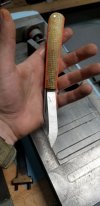You did not like your rise fall indicator?
I did not. It is just easier to put calipers and measure from the end of the spring to the pivot pin. Also, there is an issue transferring holes from the jig to the liners. The way I do it for a single blade
1) drill middle hole for spring into the liners, deburr
2) drill hole into piece of hardwood, lay both liners and spring on top and put in middle pin
3) position the blade on the liners so that it is up the spring end nice and tight and at a good angle, then clamp it down
4) drill through the blade pivot hole though both liners and into the wood, deburr
5) put pin in blade pivot hole and position the blade and spring, hold it tight, and draw a pencil line along the outside of the spring
6) remove the blade and rotate the spring to make a gap at the end opposite the blade pivot
7) clamp the spring down, drill through the spring end hole and both liners, deburr
There you got perfectly align holes. This is hard to do with a rise-fall indicator without having the rebuild it all the time, too much hassle.













